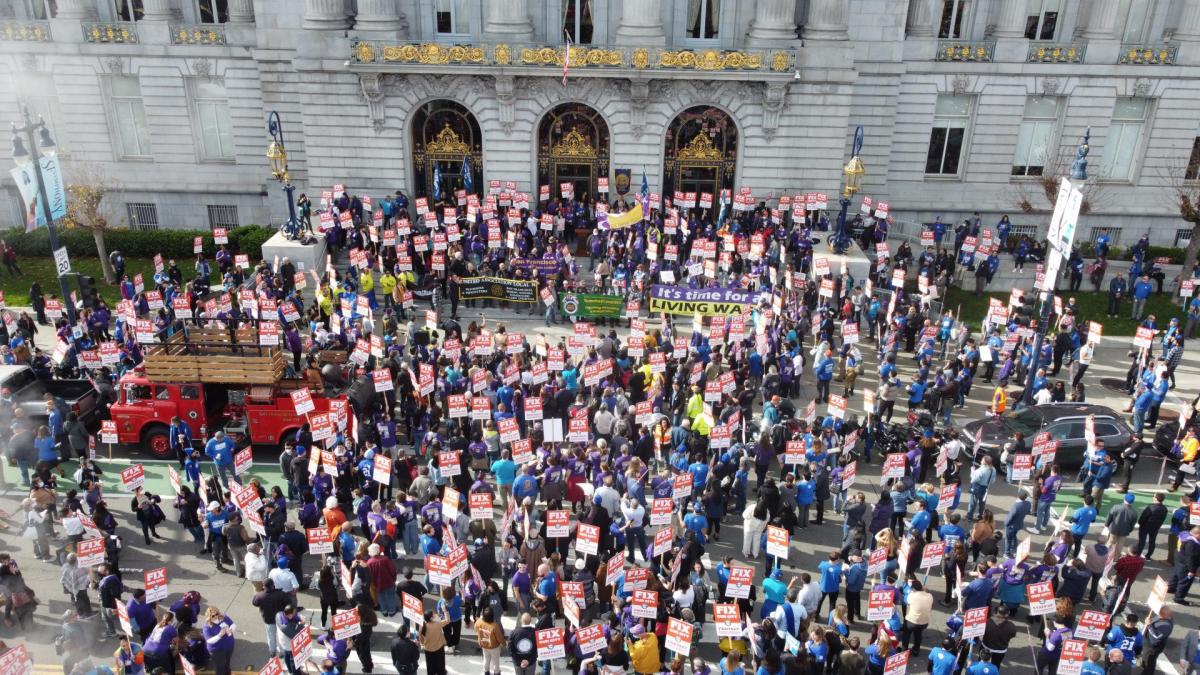Introduction:
In San Francisco, a city known for its bustling streets and vibrant culture, there’s a lesser-known story unfolding behind the scenes. While tourists admire the iconic landmarks and residents enjoy the diverse amenities, the city’s workforce is grappling with a pressing issue: understaffing. Behind the scenes, city workers are rallying to demand more staffing, unveiling a secret that has long been overlooked.They’re rallying, not just for themselves, but for the betterment of their beloved city. This article delves deep into the heart of the SF city workers rally to demand more staffing, uncovering the hidden motivations and unveiling the secrets driving their cause.
Current Situation : SF City
The current staffing levels in various city departments paint a concerning picture. From public works to social services, many departments are operating with limited resources and stretched thin. As a result, workers are facing immense challenges in meeting the needs of the community effectively.
Reasons Behind Understaffing
Several factors contribute to the pervasive issue of understaffing. Budget constraints and fiscal challenges have forced city departments to make difficult decisions, often resulting in understaffed teams. Additionally, attrition and difficulties in recruitment have further exacerbated the problem, leaving many positions vacant for extended periods.
Impact on Services
The impact of understaffing extends beyond the workforce, affecting the quality and timeliness of services provided to the public. Delays in public service delivery have become commonplace, frustrating both residents and employees alike. Furthermore, the increased workload and stress on existing employees have taken a toll on morale and job satisfaction.
Worker’s Perspective
City workers themselves are the best advocates for understanding the gravity of the situation. Many have voiced their concerns, highlighting the daily struggles they face due to understaffing. Stories of working overtime to compensate for staffing shortages and navigating bureaucratic hurdles have become all too familiar.
Efforts for Change : SF City
Despite the challenges, city workers have not been silent about their plight. Previous attempts to address staffing issues have been made, including collaborative efforts with city officials and labor unions. However, progress has been slow, prompting workers to take more assertive action.
Recent Rally
In a show of solidarity and determination, city workers recently organized a rally to demand more staffing. With banners waving and voices raised, they made their goals clear: to shine a spotlight on the issue and compel officials to take meaningful action. The rally served as a powerful reminder of the resilience and unity of the city’s workforce.
Response from Officials
City officials have taken note of the workers’ demands and have pledged to address the staffing issues. Statements acknowledging the challenges faced by city workers have been issued, along with promises to prioritize staffing needs in future budget allocations. While these responses are a step in the right direction, workers remain cautiously optimistic about tangible outcomes.
Public Support and Awareness
The rally has garnered significant public support and raised awareness about the issue of understaffing. Social media campaigns and community outreach efforts have helped amplify the workers’ message, rallying residents to stand in solidarity with their city’s workforce. The groundswell of support has added momentum to the workers’ efforts for change.
Potential Solutions
Addressing understaffing will require a multifaceted approach. Allocating more funds for recruitment and retention efforts is essential, as is streamlining hiring processes to expedite filling vacant positions. Additionally, offering incentives to attract and retain qualified candidates can help alleviate staffing shortages in the long term.
Future Outlook : SF City
As the rallying cry for more staffing grows louder, the future of San Francisco’s city departments hangs in the balance. Continued advocacy and engagement will be crucial in ensuring that the issue remains at the forefront of public discourse. By working together, city workers and officials can pave the way for a brighter future, where adequate staffing ensures the efficient delivery of essential services to all residents.
The Call for Action
Amidst the hustle and bustle of city life, SF workers have united under one banner: the demand for increased staffing. This section explores the reasons behind their call for action and the challenges they face.
Understanding the Staffing Crisis
Delve into the staffing crisis plaguing SF city workers. Explore the understaffing issues across various sectors, from sanitation to public safety, and its impact on both employees and residents.
Unveiling the Root Causes
Peel back the layers to uncover the root causes behind the staffing shortage. From budget constraints to recruitment challenges, understand the complex factors contributing to the crisis.
The Human Side of the Movement : SF City
Meet the faces behind the rally as we spotlight the stories of SF city workers. From frontline heroes to essential personnel, discover the human side of the movement and the personal struggles driving their demand for change.
Building Momentum
Explore the strategies employed by rally organizers to build momentum and garner support for their cause. From grassroots activism to social media campaigns, learn how SF city workers are amplifying their voices.
The Path to Progress
Chart the path to progress as SF city workers navigate negotiations and advocate for policy changes. Explore potential solutions and the road ahead as stakeholders work towards a resolution.

The Importance of Solidarity : SF City
Fostering Unity
Examine the role of solidarity in the SF city workers rally. Discover how collective action strengthens their cause and empowers workers to demand change.
Overcoming Challenges Together
Explore the challenges faced by SF city workers and the power of unity in overcoming adversity. From union negotiations to community support, learn how solidarity fuels the fight for increased staffing.
Shortage of Workers in SF City Services
At the heart of the issue lies a stark reality: key city departments are operating with significantly fewer staff members than needed to meet the demands of a growing population. This shortage has led to overburdened workers, stretched resources, and, ultimately, a decline in the quality of public services.
Impact on Public Services
The effects of the staffing shortage are felt far and wide. Garbage collection schedules are delayed, public transit routes are understaffed, and wait times at essential service centers have skyrocketed. The ripple effects of these deficiencies are evident in the daily lives of residents, who increasingly find themselves grappling with the consequences of inadequate staffing.
Reasons Behind the Staffing Shortage
Budget Constraints
One of the primary drivers behind the staffing shortage is budget constraints faced by city departments. With limited funding allocated for personnel expenses, hiring new employees or retaining existing ones becomes a challenging endeavor. As a result, departments are forced to make do with fewer staff, exacerbating the strain on existing workers.
Attrition Rates
Compounding the issue is the high attrition rate among city workers. Retirement, career changes, and attrition due to burnout or dissatisfaction contribute to a steady outflow of experienced personnel from crucial roles. Despite efforts to recruit and retain talent, the rate of attrition continues to outpace hiring efforts, further widening the staffing gap.
Recruitment Challenges
Additionally, recruiting new talent poses its own set of challenges. The competitive job market, coupled with the high cost of living in San Francisco, makes it difficult to attract qualified candidates for essential positions. Moreover, bureaucratic hurdles and lengthy hiring processes further impede recruitment efforts, leaving many positions vacant for extended periods.
The Rally: A Call for Action
In response to these mounting challenges, city workers organized a rally to amplify their voices and demand action from city officials. Hundreds of workers from various departments gathered in solidarity, brandishing signs and chanting slogans calling for increased staffing and support.
Response from Authorities
The rally did not fall on deaf ears. City officials, recognizing the validity of the workers’ concerns, have pledged to address the staffing shortage head-on. Plans are underway to allocate additional resources to critical departments, streamline hiring processes, and implement retention strategies to stem the tide of attrition.
Impact on Communities
Effect on Essential Services
The rallying cry for more staffing is not just about numbers; it’s about ensuring the well-being of communities. Adequate staffing is essential for maintaining the quality and accessibility of vital services that residents rely on daily. From ensuring clean streets to providing timely emergency response, the presence of sufficient staff is indispensable for a thriving city.
Public Support for Workers
The rally has garnered widespread support from residents who recognize the vital role that city workers play in maintaining the fabric of urban life. From grassroots campaigns to social media movements, there is a groundswell of solidarity with the workers’ cause, signaling a collective determination to effect positive change.
FAQs
Why are SF city workers rallying for more staffing?
SF city workers are rallying for increased staffing to address chronic understaffing issues across various sectors, ensuring the efficient delivery of essential services to residents.
What impact does understaffing have on city workers?
Understaffing puts immense strain on city workers, leading to burnout, increased workloads, and decreased morale. It also compromises the quality and timeliness of services provided to the community.
How can the community support the SF city workers rally?
The community can show support by advocating for policy changes, contacting local representatives, and participating in solidarity events. Additionally, spreading awareness through social media and word of mouth can amplify the workers’ message.
What steps are being taken to address the staffing crisis?
Rally organizers are engaging in negotiations with city officials, advocating for budget allocations, and working to improve recruitment and retention efforts. These efforts aim to address the root causes of the staffing shortage and implement sustainable solutions.
What role does the union play in the rally?
The union serves as a vital ally for SF city workers, providing resources, legal support, and collective bargaining power. They play a central role in organizing the rally and advocating for workers’ rights.
How can individuals outside of San Francisco support the cause?
Individuals outside of San Francisco can show support by amplifying the workers’ message on social media, donating to relevant organizations, and contacting elected officials to voice their support for increased staffing.
Conclusion:
In the heart of San Francisco, amidst the hustle and bustle of urban life, a silent struggle is taking place. City workers, the backbone of the community, are rallying to demand more staffing, shedding light on a long-ignored secret. As the city grapples with the consequences of understaffing, the time for action is now. By standing together and advocating for change, we can ensure that San Francisco remains a city where every voice is heard, and every need is met.it’s a testament to the resilience and determination of workers striving for a better future. By uncovering the secrets behind their cause and rallying together in solidarity, SF city workers are paving the way for positive change in their community.









